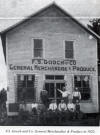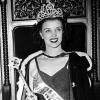| |
 Waynesburg,
located south of Stanford, was named in honor of General
Anthony Wayne, a Revolutionary War hero. The town was
settled in the early 1800s. According to the Lincoln
County Deed Books, the early settlers were as follows:
Singletons, Reynolds, Gouaches, Caldwell's, Trowbridges,
Barnetts, Estes, Morgans, Lees, McMullins, Leaches,
Sweeneys, Youngs, Williams, Padgetts, McKinneys, Smiths,
Jacobs, Bastins, Hortons, Sims, Mitchells, Ellisons,
Lanigans, Campbells and Routins. Waynesburg,
located south of Stanford, was named in honor of General
Anthony Wayne, a Revolutionary War hero. The town was
settled in the early 1800s. According to the Lincoln
County Deed Books, the early settlers were as follows:
Singletons, Reynolds, Gouaches, Caldwell's, Trowbridges,
Barnetts, Estes, Morgans, Lees, McMullins, Leaches,
Sweeneys, Youngs, Williams, Padgetts, McKinneys, Smiths,
Jacobs, Bastins, Hortons, Sims, Mitchells, Ellisons,
Lanigans, Campbells and Routins.
Double Spring Baptist Church was
established in 1803. It has been in four different
loactions but has always been located near two Springs.
The first post office was established in 1824. This post
office has moved eight times. Between 1827-28 the post
office was closed. The mail for the community was
carried by Pony Express until 1893. A mail route was
established in 1900 with Taylor Wesley as the first mail
carrier.
A stage route was established
between Somerset and Stanford. The regular stage stop at
Waynesburg was at the Routen place. Mr. Acton Routin’s
father made the last stagecoach run..
 Some changes came
with the railroad. Waynesburg moved from the stagecoach
line to its present location in the 1890s Dr. A. K. Caldwell
opened his office across the railroad. He served the
residents of Waynesburg for about
20 years. Dr. Caldwell was born in 1866 and died in
1920. Other doctors have been Dr. Jasper who died in a
railroad accident, Dr. H. C. Dye and Dr. Davison, a
dentist.entist. Some changes came
with the railroad. Waynesburg moved from the stagecoach
line to its present location in the 1890s Dr. A. K. Caldwell
opened his office across the railroad. He served the
residents of Waynesburg for about
20 years. Dr. Caldwell was born in 1866 and died in
1920. Other doctors have been Dr. Jasper who died in a
railroad accident, Dr. H. C. Dye and Dr. Davison, a
dentist.entist.
The town of Waynesburg
has been supported by many businesses
and civic organizations. Merchants
who owned stores or businesses by the
railroad. were Dutch Gooch,
Fred Gooch, M. R. Wheeldon, John Burlician,
Acey Morgan and Aven Horton.
 In the late 1800. Mr
Dan Caldwell became the first undertaker in
Waynesburg. The second was Clark
Gerden in 1905. The third was J. M.
Reynolds in the 1930. and then C.R.
Barnett. In the late 1800. Mr
Dan Caldwell became the first undertaker in
Waynesburg. The second was Clark
Gerden in 1905. The third was J. M.
Reynolds in the 1930. and then C.R.
Barnett.
The chimney still
stands on the Calvin Greer farm where the
first school building stood.
The Masonic Lodge No.
328 was established in 1855
The Waynesburg Deposit Bank was built and
incorporated in 1907 with a total stock of
$75,000. Mr Gadberry was the first teller. The directors were Jimmie Hayes,
President R. Y. Ballard, Clay Elliott, Mrs.
L
Gooch and Virgil McKenzie. M. E. Wheeldon,
cashier, earned $50 per month and Mr.
Mullins, assistant cashier, earned $25 per
month. the bank stood in the middle of town
and The directors decided to close the
bank in 1931 during the Great Depression,
but
no one lost any money. Waynesburg’s second
bank was opened in 1982 as a branch of
Lincoln County National Bank. A mobile unit
was first used and later was replaced by a
permanent in 1983. The branch manager
was Ivan Singleton and the secretary and
teller was
Mrs. Verna Reynolds.
Waynesburg has had three
factories. A canning factory, which prepared tomatoes
and mo lasses, was located across from the present Ed
Buis Furniture Store and north of Dr. G. B. Williams
home. They used dogwood to help in making it. Allen
Horton ran this factory. It stayed open for two years,
and then closed.
 Singleton’s Mill, shown, is
located in Waynesburg. The second one was a steering
wheel factory, located at the site of the Waynesburg
Lumber Company. A Mr. Jones ran it. They made steering
wheels for cars and trucks. It stayed open for two
years. The third factory, the Delco Plant, was in
operation in 1918. This factory remained in operation
for a year. Waynesburg had a hotel located near the rail
road called Warriner Hotel and later the Horton Hotel.
Salesmen from all over the country stayed in the hotet. Singleton’s Mill, shown, is
located in Waynesburg. The second one was a steering
wheel factory, located at the site of the Waynesburg
Lumber Company. A Mr. Jones ran it. They made steering
wheels for cars and trucks. It stayed open for two
years. The third factory, the Delco Plant, was in
operation in 1918. This factory remained in operation
for a year. Waynesburg had a hotel located near the rail
road called Warriner Hotel and later the Horton Hotel.
Salesmen from all over the country stayed in the hotet.
A modern, one story structure, has
replaced the old school. The old gray, stone structure
was a two story with a basement. Some of the teachers
of the Waynesburg School were Oakley Lanhan, R. H.
Playforth, S. M. Cook, Delmar Wallace, G. W. Durr, Mrs.
Roy McKeethan, Faunice Hubble, Leonard Horton, Columbus
Hines, Alma Sanders, Mrs. Lavina Diamond, Ruby Frazier,
Mrs. Mary Thompson, Guy Pennington’s
father-in-law, Calvin Greer, James Bryant and Louis
Estes.A
 Miss Venus Ramey a former
Waynesburg student was selected and crowned as Miss
Lincoln County on Sept. 20,
1939
at the Lincoln County
School Fair held at Hustonville. Later she entered more
beauty contests and became Miss America in 1944 . Miss Venus Ramey a former
Waynesburg student was selected and crowned as Miss
Lincoln County on Sept. 20,
1939
at the Lincoln County
School Fair held at Hustonville. Later she entered more
beauty contests and became Miss America in 1944 .
|
|
